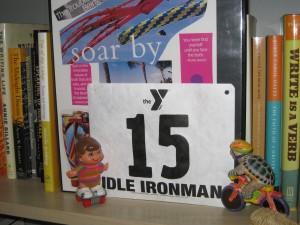How to Juggle Multiple Tasks by Rochelle Melander
Today’s tip talks about how learning how to shift tasks is essential for writing. It’s the fifth article in our series on writing productivity based on the book Organize Your Mind, Organize Your Life: Train Your Brain to Get More Done in Less Time by Paul Hammerness, M.D., Margaret Moore, and John Hane. The first four articles are available on the blog. Find the links at the end of today’s article. Happy writing, Rochelle, the Write Now! Coach
 How to Juggle Multiple Tasks by Rochelle Melander
How to Juggle Multiple Tasks by Rochelle Melander
Don’t mistake activity with achievement. —John Wooden
I like a challenge. And I like working on that challenge with others. So I signed up for the Idle Ironman—that’s an oxymoron—at the Y. In the month of March, I’ll bike 112 miles, run 26.2 miles, and (gulp) swim 2.4 miles. Because the wellness staff at the Y wants to encourage users try new machines and programs, we can make substitutions. For example, I’ll be taking water aerobics instead of swimming.
Today, I figured out the challenge and blessing of this program: I can’t just run-walk every day. I’ll need to bike as well. This will require a whole new level of flexibility for me. If I’m going to finish this thing, I’ll need to split many of my workouts between cycling and running. I’ll need to learn how to shift from one activity to another.
Which brings me to the writing thing: writers juggle many kinds of tasks. We don’t just write our books. (Oh if it were that easy!) We research, revise, query, submit, and track markets. Add to that the work we do promoting our books—building relationships on social media, blogging, tweeting, pinning, and more. And don’t forget the whole day job thing. If we’re not out speaking about our work, most of us are holding down one or two jobs to pay for our writing habit. Finally, we need to do a few things to keep body and soul together—eating, sleeping, connecting with friends and family, and keeping up appearances! In order to do all that we do, we need to master the skill of flexibility—and the ability to shift from task to task.
According to the authors of Organize Your Mind, Organize Your Life: Train Your Brain to Get More Done in Less Time, once we’ve tamed the frenzy, focused on writing, wandered off to watch the squirrels try to take over the bird feeder, refocused on writing, and then accessed our bits of stored information—we need to learn how to shift to the next task. The authors call this “shifting sets.”
What it is: This is the ability to be flexible in both our thinking and our behavior and shift from one task to another throughout the day. Note that this is not multitasking or what some researchers call serial tasking, when we switch rapidly between tasks.
What it looks like for writers: This is a key function for writers. Yes, we need to focus wholeheartedly on our current writing project. We also need to shift our focus between many other tasks including researching markets, developing relationships with agents, editors, and publishers, marketing our work, and creating new streams of income.
How to do it: Let’s start with the foundation for this practice. Once you get to this step, you’ve already conquered a few things:
*You have a vision. You know what you want to accomplish in the next five years.
*You have a goal (or two). You know what you need to accomplish to reach your vision.
*You have a plan. You have divided your goals into small steps.
*You have a schedule. You have set aside time in your calendar to accomplish each of these small steps.
Now that you’ve mastered all this (yeah you!), how do you shift between tasks?
Cluster tasks. Most people find shifting sets to be challenging because they are shifting every 30 seconds (serial tasking). You’ve been there: write a sentence, check email, write another sentence, check Facebook, research, write another sentence, check Twitter, and repeat. That’s insane—and interrupts your ability to practice sustained attention (which you need to write). Instead, cluster like tasks together. Instead of switching between writing and social media every five minutes, schedule an hour during the day to do email and another hour to work on social media. That way, you will still get to everything but you will have to shift between tasks less times during the day.
Provide transition time. All students, from kindergarten through high school get time to move between classes. Why shouldn’t you? In Organize Your Mind, Organize Your Life, the authors suggest using physical stress-busting activities like walking, stretching or lifting weights between activities in order to perform better on the next task. Besides, as I’ve written here before, that kind of moving around during the day is good for you! (See The Fit Writer.)
Create work zones. The prolific author, poet, and playwright Sir Walter Scott had an enormous desk with two working surfaces so that he could work on multiple projects at once. I’ve adopted Scott’s practice and added a second desk in my office so that I can physically move between projects. When we physically shift spaces, we remind our brain that it’s time to switch activities. Think about how you can make use of various spaces in your house or neighborhood to more easily shift between work activities. If you can’t move out of your desk, think about how you can signal to yourself that you’re shifting between tasks. Try:
*Creating project folders that you can take out for each task and put away afterwards. You can also do this electronically, which may give you the same feeling of moving from one task to another.
*Using a symbol. I hear people talk about the many hats they wear at work. In the past, I’ve used real hats to help me shift sets—wearing my crown when I need to tap into my royal authority. Currently, I have a collection of small creatures near my computer. When I need to be methodical, I pull out the turtle. But when I want to tap into my inner child, I take out the red headed troll. Use whatever symbols help you to shift between tasks.
Finally, at the end of the day—clean up your computer desktop and your physical office space so that you can make the big shift from work life to the rest of your life. This will prevent you from showing up at the networking event or your kid’s school with a book hangover. You know what that is, don’t you? You’re present but your head is still in the book—so when someone asks you what you think about Downton Abbey, you look at them with that deer-in-the headlights stare. (Yikes!)
Your turn: What tools have helped you shift between tasks?
Read the first four articles in this series:
Tame the Frenzy http://bit.ly/Xwjp6H
How to Focus on a Task https://writenowcoach.com/?p=1532
Apply the Brakes and Write More https://writenowcoach.com/?p=1589
Improve Your Memory and Write More https://writenowcoach.com/?p=1628














